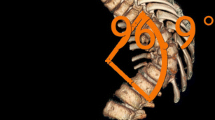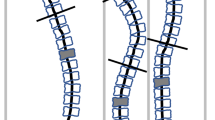Abstract
Objective
Assessment of scoliotic curve flexibility and stiffness is essential for planning surgical treatment in adolescent idiopathic scoliosis (AIS). Measurement of curve flexibility is currently insufficiently precise. The purpose of this study was to introduce and validate a novel method of superimposing radiographs for more reliable measurement of curve flexibility.
Material and methods
Two independent radiologists measured Cobb angles separately on standard anterior-posterior (AP) (n = 48) and supine bending radiographs (n = 48), in patients with AIS, who were randomly included from a surgical database. The same readers repeated the measurements after the bending radiographs were semi-automatically superimposed on the AP radiographs by fusing the caudad end vertebra. Curve flexibility was calculated. Inter-reader agreement between the two independent readers was calculated using interclass correlation coefficient (ICC).
Results
A moderate inter-reader agreement was achieved in the upper curve (ICC = 0.57) and a good agreement in the lower curve (ICC = 0.72) with the standard method of assessing curve flexibility. With the use of the semiautomatic superimposition, however, almost perfect agreement was achieved for both the upper and the lower curves flexibilities (ICC = 0.93 and 0.97, respectively).
Conclusion
The introduced semi-automatic superimposition technique for measurement of scoliotic curve flexibility in AIS is more precise and reliable than the current standard method.
Key Points
• A technique using semiautomatic superimposition of anterior-posterior and bending radiographs is introduced
• Almost perfect agreement was achieved for scoliotic curves flexibilities measurements
• This method is more precise and reliable than the current standard method



Similar content being viewed by others
References
Rogala EJ, Drummond DS, Gurr J (1978) Scoliosis: incidence and natural history. A prospective epidemiological study. J Bone Joint Surg Am 60:173–176
de Souza FI, Di Ferreira RB, Labres D et al (2013) Epidemiology of adolescent idiopathic scoliosis in students of the public schools in Goiânia-GO. Acta Ortop Bras 21:223–225
Aubin C-E, Labelle H, Ciolofan OC (2006) Variability of spinal instrumentation configurations in adolescent idiopathic scoliosis. Eur Spine J 16:57–64
Robitaille M, Aubin CE, Labelle H (2007) Intra and interobserver variability of preoperative planning for surgical instrumentation in adolescent idiopathic scoliosis. Eur Spine J 16:1604–1614
Carman DL, Browne RH, Birch JG (1990) Measurement of scoliosis and kyphosis radiographs - intraobserver and interobserver variation. J Bone Joint Surg Am 72A:328–333
Duong L, Cheriet F, Labelle H et al (2009) Interobserver and intraobserver variability in the identification of the Lenke classification lumbar modifier in adolescent idiopathic scoliosis. J Spinal Disord Tech 22:448–455
Phan P, Mezghani N, Nault M-L et al (2010) A decision tree can increase accuracy when assessing curve types according to lenke classification of adolescent idiopathic scoliosis. Spine 35:1054–1059
Hosseinpour-Feizi H, Soleimanpour J, Sales JG, Arzroumchilar A (2011) Lenke and King classification systems for adolescent idiopathic scoliosis: interobserver agreement and postoperative results. Int J Gen Med 4:821–825
Lenke LG, Betz RR, Harms J et al (2001) Adolescent idiopathic scoliosis: a new classification to determine extent of spinal arthrodesis. J Bone Joint Surg Am 83-A:1169–1181
Jr C (1948) Outline for the study of scoliosis. Instructional course lectures. Am Acad Orthop Surg 5:261–275
Lenke LG (2005) Lenke classification system of adolescent idiopathic scoliosis: treatment recommendations. Instr Course Lect 54:537–542
Cheung KMC, Natarajan D, Samartzis D et al (2010) Predictability of the fulcrum bending radiograph in scoliosis correction with alternate-level pedicle screw fixation. J Bone Joint Surg Am 92:169–176
Luk K, Cheung K, Lu DS, Leong J (1998) Assessment of scoliosis correction in relation to flexibility using the fulcrum bending correction index. Spine 23:2303–2307
Malfair D, Flemming AK, Dvorak MF et al (2010) Radiographic evaluation of scoliosis: review. AJR Am J Roentgenol 194:S8–S22
Pruijs J, Hageman M, Keessen W et al (1994) Variation in Cobb angle measurements in scoliosis. Skeletal Radiol 23:517–520
Morrissy RT, Goldsmith GS, Hall EC et al (1990) Measurement of the Cobb angle on radiographs of patients who have scoliosis - evaluation of intrinsic error. J Bone Joint Surg Am 72A:320–327
Goldberg MS, Poitras B, Mayo NE et al (1988) Observer variation in assessing spinal curvature and skeletal development in adolescent idiopathic scoliosis. Spine 13:1371–1377
Hamzaoglu A, Talu U, Tezer M et al (2005) Assessment of curve flexibility in adolescent idiopathic scoliosis. Spine 30:1637–1642
Lamarre M-E, Parent S, Labelle H et al (2009) Assessment of spinal flexibility in adolescent idiopathic scoliosis suspension versus side-bending radiography. Spine 34:591–597
Acknowledgments
The authors would like to thank the ETH of Zurich and particularly Zoé Goey from the Computer Vision Laboratory for the production and support of the software. The scientific guarantor of this publication is Thomas Frauenfelder. The authors of this manuscript declare relationships with the following company: ETH, Zurich, Switzerland. The authors of this manuscript declare no relationships with any companies, whose products or services may be related to the subject matter of the article. The authors state that this work has not received any funding. One of the authors has significant statistical expertise. Institutional Review Board approval was not required because of the retrospective study design. Written informed consent was not required for this study because of its retrospective design. Methodology: retrospective, observational, performed at two institutions.
Author information
Authors and Affiliations
Corresponding author
Rights and permissions
About this article
Cite this article
Farshad-Amacker, N.A., Nguyen, T.D., Farshad, M. et al. Semiautomatic superimposition improves radiological assessment of curve flexibility in scoliosis. Eur Radiol 25, 860–864 (2015). https://doi.org/10.1007/s00330-014-3433-1
Received:
Revised:
Accepted:
Published:
Issue Date:
DOI: https://doi.org/10.1007/s00330-014-3433-1




